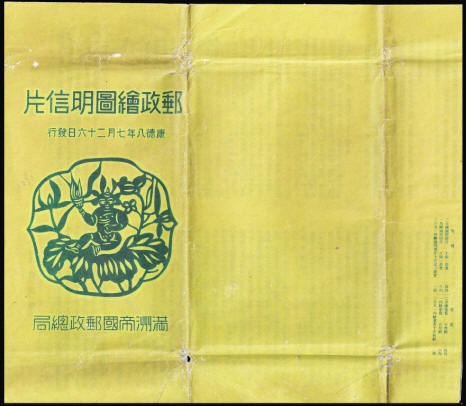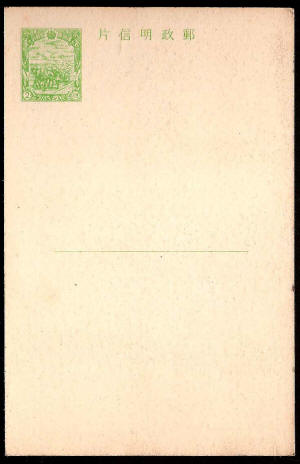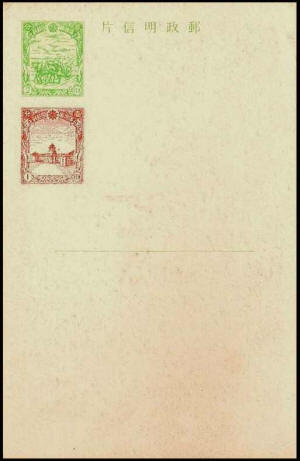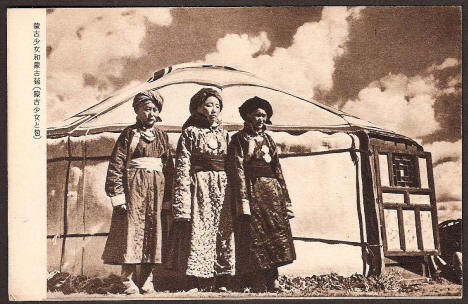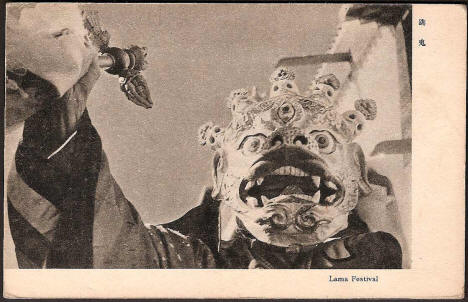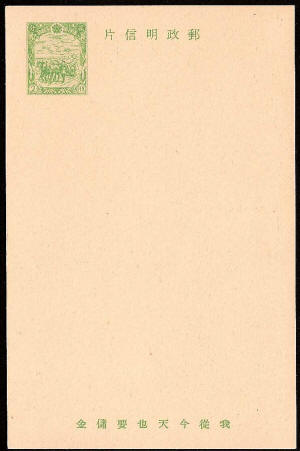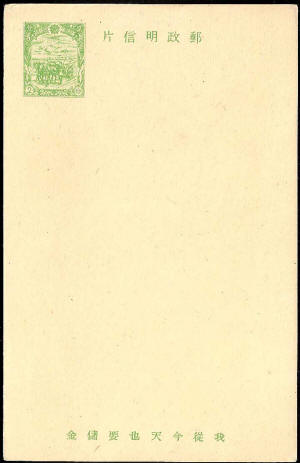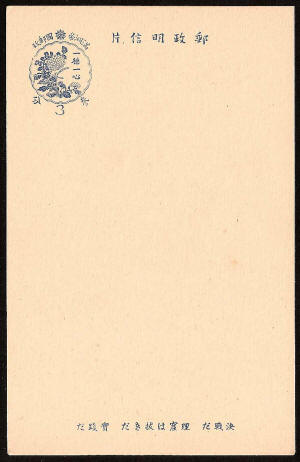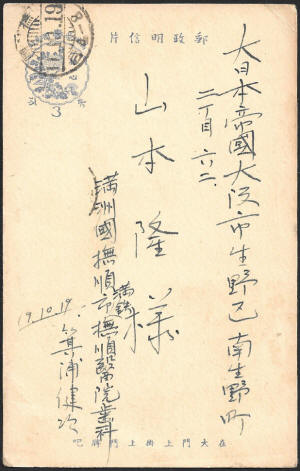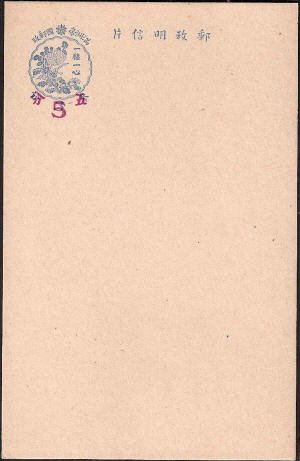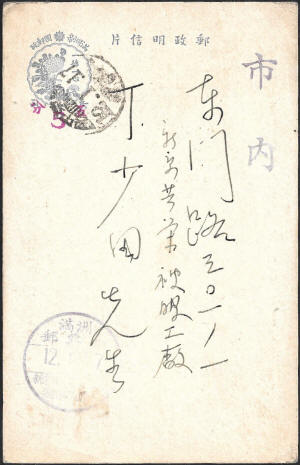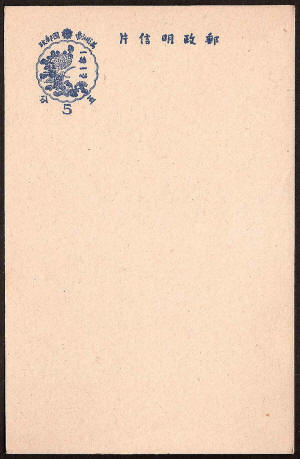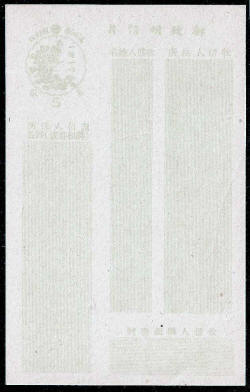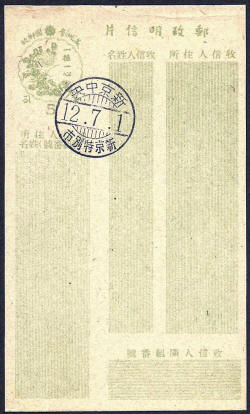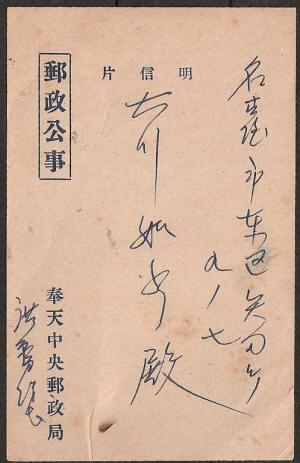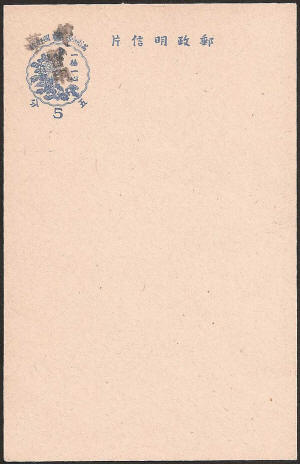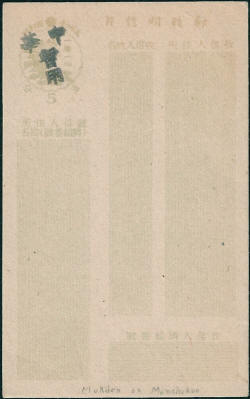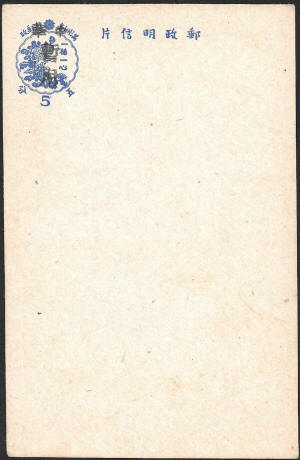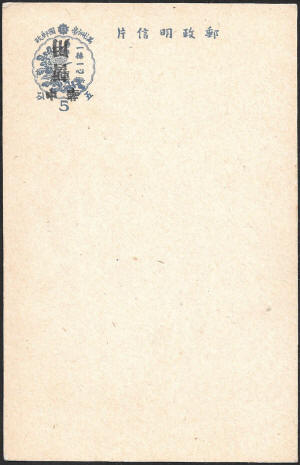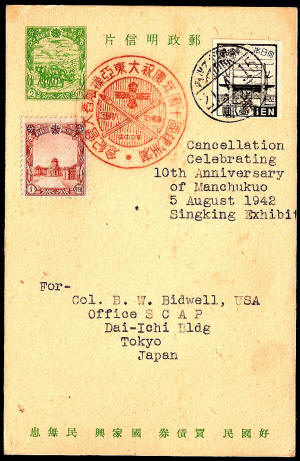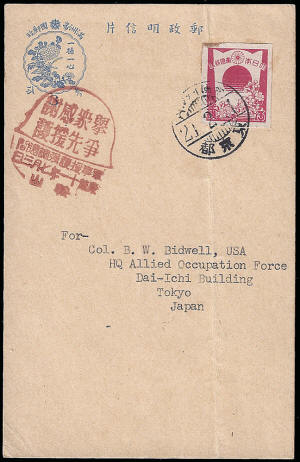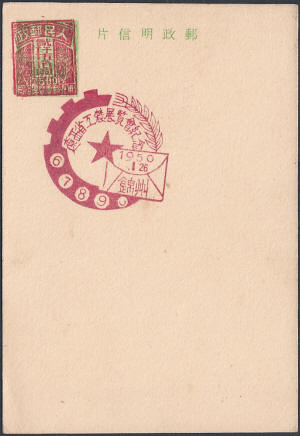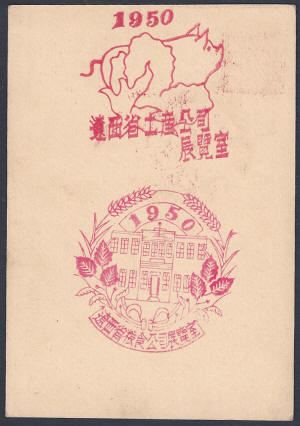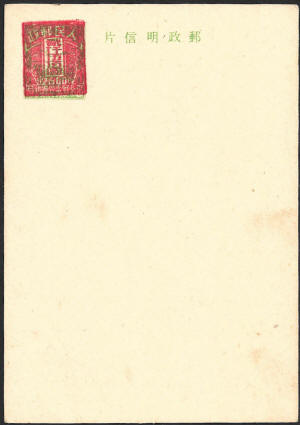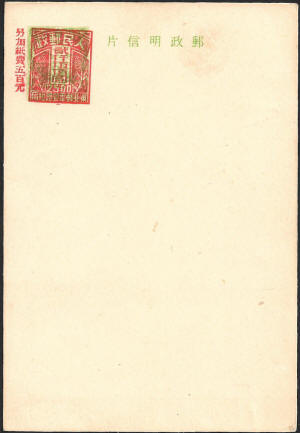 |
|||||
|
Pre-Stamped Postcards Imprinted Postcards 1932 to 1934 Imprinted Postcards 1935 to 1939 Imprinted Postcards 1940 to 1950 Post Office Issued Picture Post Cards Abolition of Extraterritorial Rights
|
|||||
|
Postcards 1940 to 1950 26th July 1941 - Imprinted Picture Postcards On 26th July 1941 a new series of the 2f and 10f imprinted postcards in 15 designs became available for purchase at the five largest post offices, Hsinking, Mukden, Harbin, Chinchou and Mutankiang. The cards were sold as a set, in a green folder with a description of each card in blue, printed in Chinese and Japanese. The 15f cards were the only cards issued in Manchukuo with the heading "Post Card" written in English. The 2f cards, for domestic use, had five Chinese characters reading "Postal Service Post Card" as a heading. The original plan was to issue new sets of picture cards every six months, but as the first issue failed to sell in sufficient numbers this idea was dropped. The probable reason for the lack of sales was the competition being offered by private printers who were offering more commercial and attractive designs, the government issue being pretty dull by comparison. Picture Cards Wrapper. 郵政繪圖明信片 Postal Postcards. This postcard wrapper gave a printed account of each card, location and photographer. To see the full wrapper click here for side 1 and here for side 2. |
|||||
|
2f Card from 1st March 1942 |
3f Up-rated Card from 28th January 1944. |
||||
|
Above is an example of the 2f (domestic) picture postcard, face and reverse. This card shows three Mongolian girls and a yurt. A full list of titles includes; |
|||||
| The shrine to the founding of the state at Hsinking. | A Tibetan Temple at Chengde. | ||||
| The Manchukuo National Museum at Mukden. | Lake Chingpo. | ||||
| The White Pagoda at Liaoyang. | A modern tractor clearing land for cultivation. | ||||
| The Central Temple at Harbin. | Spinning Wool. | ||||
|
Three Mongolian Girls (See above) |
|||||
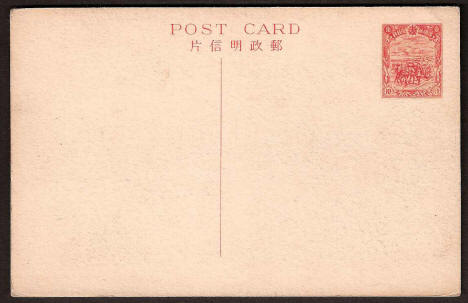 |
|||||
|
Above is an example of the 10f (foreign mail) postcard. This was printed on better quality card and had captions in both English and Chinese, in this instance the English caption reads "Lama "Festival", and in Chinese "Dancing Devil", other pictures included; |
|||||
| Tatung Avenue in Hsinking. | The Yacht Club at Harbin. | ||||
| Peiling (North Mausoleum) at Mukden. | The Summer Palace at Chengte. | ||||
|
On 1st March 1942, the domestic mail cost increased to 3f and it was decided to imprint a 1f stamp on all cards that remained unsold. The new cards with the additional 1f imprinted stamp did not go on sale until 28th January 1944 (see above). The re-valued cards were available from the post offices listed above and also from any of the places shown in the pictures, for instance Anshan, or Liaoyang, etc., the cards were sold singly at 5f each, the postage 3f plus a 2f charge for the card itself. A forerunner of these designs may be some promotional postcards produced by the Wakaso Medical Co., in support of the Manchukuo Development Labour Service Organization. Click here for more details. |
|||||
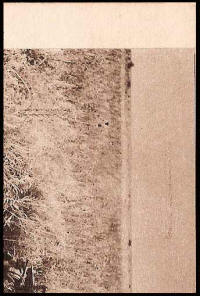 |
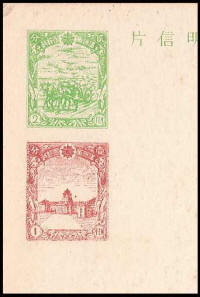 |
||||
|
Feint offset of the imprinted 1f stamp on the face of the "tractor clearing land for cultivation" card. |
|||||
|
2nd May 1941 - First Series of Imprinted Postcards with Slogans On 2nd May 1941 a new version of the 2f imprinted postcard was issued and for the first time in Manchukuo these cards had slogans written in Chinese or Japanese across the bottom. There are a total of 28 different versions of this card, 16 with slogans in Chinese and 12 with slogans in Japanese. In 1940 it is estimated that over 40 million postcards were sold in Manchukuo, and it must have occurred to someone that this provided an ideal opportunity for propaganda. In July 1940 various ministries were asked to submit short slogans to be printed at the bottom of the 2f postcard. In all over 150 suggestions were received and after a selection process 28 were chosen to be included on a 2f Postcard. To see translations of the slogans, view this page in the Microsoft Explorer browser and hover your mouse over each slogan shown below. The reason 28 slogans were chosen was due to the size of the printing plates to be used. The plates had room for 56 cards, this meant 2 of each could be printed at a time. In fact, and for reasons that are unclear, the plates used in the printing had 56 versions of the same card, this drastically slowed down the production process. By the release date of 2nd May 1941 only 4 postcard designs had reached Post Offices and ready were for distribution, the balance followed later in the same year. It is likely that around 800,000 copies of each card was produced. This is a typical message from one of the slogans 好国民,买债券,国家興,民無患 "Good citizens buy (government) bonds, the country prospers and the people need not worry".
|
|||||
|
Card colours These cards were printed on two very distinctive types of card a reddish buff colour and a yellowish cream. Seen together the contrast is quite striking and has nothing to do with fading or toning. Buff Cream |
16 Chinese Slogans 12 Japanese Slogans |
||||
|
(My thanks to Mun Kit Ng of Singapore and Travis Searls of Denver for help with the above translations) |
|||||
|
Price Changes 1st March 1942 On the 1st of March 1942 the cost of sending a domestic postcard increased from 2f to 3f, however at this time no replacement cards were available with the new rate, consequently it was necessary for the post offices to up-rate old cards using existing postage stamps. A variety of combinations of cards and stamps were used for this purpose and this process was also applied to the 3f reply paid cards. The standard method of up-rating a card used by the Post Office was to apply the extra stamp or stamps below the imprinted stamp, leaving the legend at the top of each card fully readable. Where this practice is not followed it is likely that the card has been up-rated by the user.
|
|||||
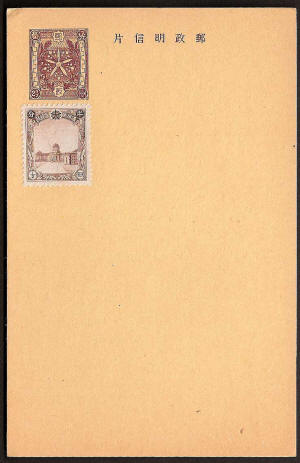 |
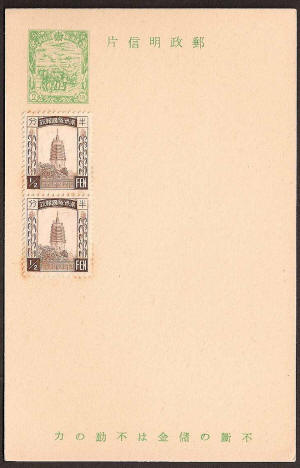 |
||||
| Up-rated 1937, China Mail 2½f Imprinted postcard. They were sold like this by Post Offices until the new 3f design became available in September 1942. | Up-rated 1941, 2f Imprinted postcard with slogan. | ||||
 |
 |
||||
|
|
|||||
|
Up-rated 1941, 2f Imprinted postcard. This card was probably up-rated by an individual. Post Offices usually placed the additional stamp below the imprinted stamp. |
Up-rated 1937 2f + 2f Reply Paid Postcard with a 1934, 1f stamp prior to sale. Note that the colour of the imprinted stamp is blue (instead of green) and similar to the colour used on the new 3f design. | ||||
|
15th September 1943 - Second Series of Imprinted Postcards with Slogans On 15th September 1943 a set of new 3f imprinted postcards appeared, with four new slogans written by three famous calligraphers. The new cards were designed by Yoai Ota and Takoo Yamashita. Unlike all previous issues they were not based on existing postage stamps and were printed typographically. The new design featured the flowers found on an important historic Manchurian fabric with the addition of a slogan reading "One Virtue, One Spirit" set in an oval frame. An additional four cards with new slogans came into use throughout 1943 and early 1944. on 1st April 1944 plain cards were issued without slogans. |
|||||
|
Chinese Slogans Japanese Slogans
|
|||||
|
|
|||||
| The 15th September 1942 3f Imprinted postcards had different slogans printed at the bottom, 4 in Chinese and 4 in Japanese. Some of these are shown above. Use Microsoft Explorer and hover your mouse over each of the above slogans to see a translation and the date of issue. | |||||
|
This 3f slogan card was sent from 撫順 Fushun in Manchukuo on 19th October 1944 to 大阪 Ōsaka in Japan. In this instance the Chinese slogan reads "Hang a nameplate/number on your gate". This card carries insufficient postage - the domestic rate and the rate to Japan increased to 5f on 1st October 1944.
|
|||||
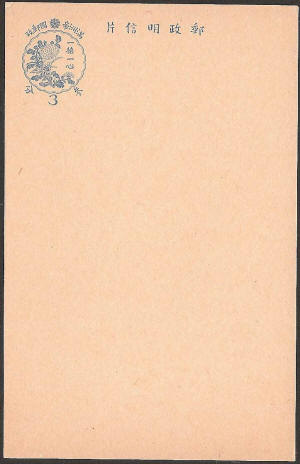 |
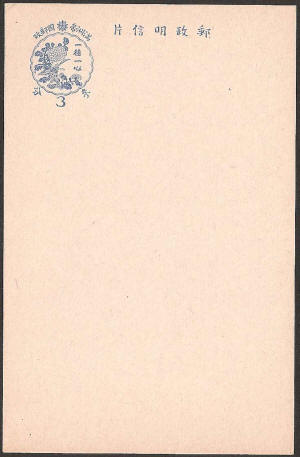 |
||||
| April 1944 - 3f imprinted postcard on buff card, without slogans. The 3 fen cards were only in use for a short period of time because the rate increased to 5f in October 1944. | June - July 1944 - 3f imprinted postcard on off white card. (Both examples shown here have a considerable amount of toning). | ||||
| 10th August 1944 3f + 3f Reply Paid Postcard for domestic mail and for mail for China and Japan. Above are both parts of this card, the left hand copy is for use by the sender and on the right is the reply section used by the recipient. | |||||
|
|
|||||
|
Price Changes 1st October 1944 The last price change took place on 1st October 1944 when the cost of sending a postcard increased to 5 fen, as with the previous increase no new cards were available, so in this instance the Post Office overprinted stocks of the 3 fen card. 1st October 1944 - February 1944 3f Chinese slogan card up-rated with the addition of a 2f stamp and an April 1942 3f plain postcard surcharged with a value of 5f for domestic use (also Japan and China). 3f Card Unrated to 5f used locally within Hsinking on 17th January 1945. The additional marking 巿内 reads City and may be postal in origin. The feint circular date-stamp at the bottom of the card probably relates to the business to which the card was sent and if so it shows the card arrived on the same day. The reverse of this card is printed in Japanese and headed 滿洲郵票報特 Manchuria Stamps - it can be seen here. 17th December 1944. A 5 fen postcard, of a similar design to the 3 fen, was introduced most of these postcards had the imprinted stamp in a light blue grey, however a variety is known with a dark blue imprinted stamp, as shown above. A 5f x 5f reply paid version of this card was designed but never issued. First Day of Issue 1st July 1945. The war was taking its toll on postal workers and printers, as a result of this a new 5f card was introduced on 1st July 1945. This featured a very feint design, this time printed in pale green on greyish-white paper with a reduced size of 77mm x 122.5mm. The second example has a first day of issue postmark from Hsinking Central P.O. The labour shortage was so great that it was decided not to cancel mail and deliver only to the local head of each Neighbourhood Association, who would then arrange for delivery on behalf of the Post Office. To prevent re-use the address side of the new 5f card had four printed panels, the design was intended to make it obvious if anyone tried to remove and original address, rewrite it and use the card again. Reading from left to right the instruction above each panel reads, Left Panel -
Senders name and address, (below)
Senders Neighbourhood Association name and number. This card was only in circulation for a little over eight weeks before the war ended. Official Postcards This is rare example of an official post office postcard, the boxed 郵政公事 reads Post Office Official and below 奉天中央郵政局 Mukden Central Post Office. The buff coloured card is the standard 90mm x 140mm size and it is likely that these were produced locally for Post Office use. The date is uncertain and can be any time from October 1935 to July 1945. Post War Usage Shortages of material meant that the postcards of Manchukuo found in stock at Post Offices where they could be overprinted and re-used. These are rare but examples can be found by diligent collectors. After the war the 5f cards appeared with black, four character, Mukden type (Chung Hwa Temporary Use) overprints. This shows that some postcards continued in use during at least part of the 1945 to 1947 transitional period. Both of these examples of 5f postcards have a local Mukden Type overprints from Chin-chow county. George Luzitano lists both of these cards in his book The Post-war Provisional Issues of North East China, MLO Volume 1. The example on the left I have identified the overprint as being listed by George Luzitano as FT34, An-tung county (although he does not associate it with a 5f postcard). The inverted example on the right is unlisted and may not be genuine. The above post cards of Manchukuo were posted in Japan are of philatelic interest. S.C.A.P. stands for Supreme Commander of the Allied Powers a post held by General Douglas MacArthur. Colonel Bidwell (Military Intelligence) was clearly attached to the post-war offices of the occupation in Japan. At this time a series of cards with commemorative date-stamps are known to have been sent to him but the sender remains anonymous, probably a fellow officer with a similar interest. Dec 1949 This is a buff Sky of Clouds type slogan card (trimmed to remove the slogan). This is the latest known usage in which the 2f Manchukuo is obliterated by a design reading 人民邮政 Peoples Post 東北郵電管理和局 "North East Post and Telecommunications Administration Bureau" and up-rated to $2500. These cards are very hard to find and come up for sale very rarely. The addition of the cachets is a bonus. The cachets read Star -
Liaohsi Province Industry & Agriculture
Exhibition 1950.1.26,
Chinchow Dec.1949. Both of the above (Sky of Lines type - on cream card) slogan cards have been trimmed to remove the slogan as a form of censorship. Both cards have been up-rated and the second version has an additional vertical row of characters 加紙責五百元 "Plus paper worth five hundred dollars".
|
|||||
|
Sources of the information used in this page - The first person to write definitively (in English) about the Imprinted Postcards of Manchukuo was Dr. Robert M. Spaulding Jr., his "The Catalogue of Postal Stationary of the Japanese Occupation of China, Part One, Manchuria", forms the core of Western knowledge of this subject and was the basis of the Higgins & Gage section on Manchukuo. I have found both works very helpful in compiling this page. Other references include the JSCA Japanese Stamp Specialized Catalogue Vol. 3 and articles from "The China Clipper", the journal of the China Stamp Society. |
|||||
|
|
|||||
